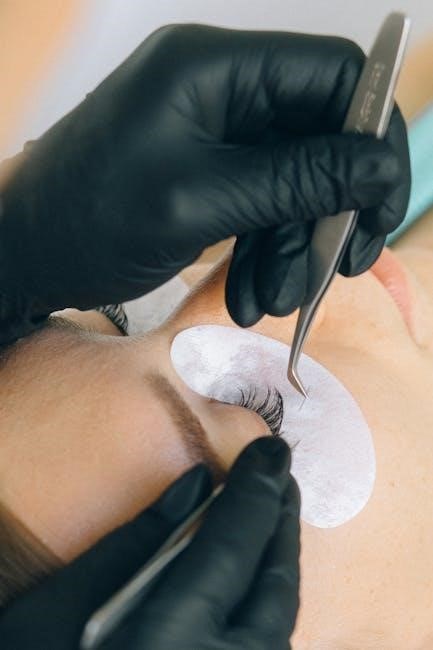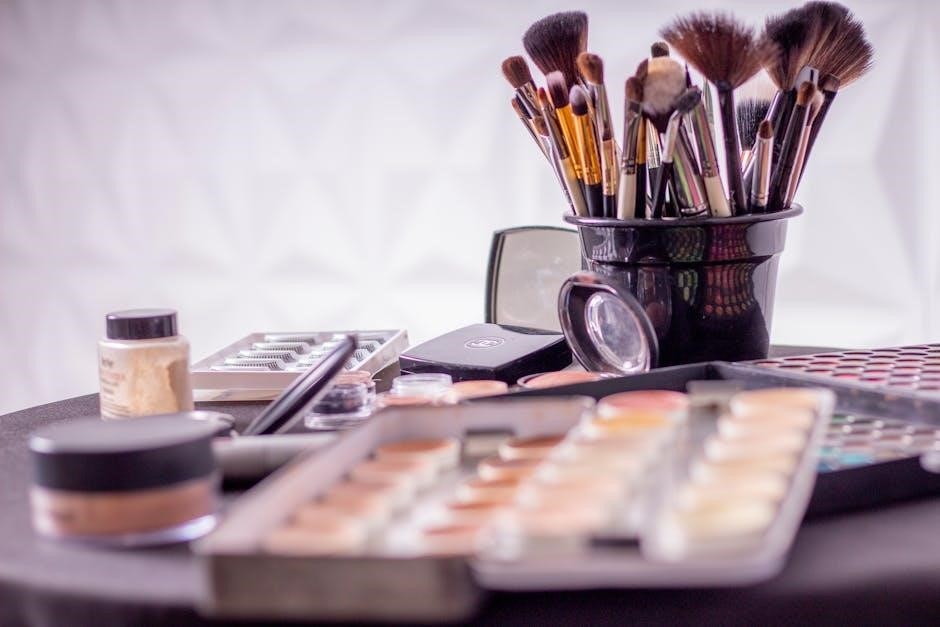Welcome to our comprehensive guide on decal application! This article will walk you through the essential steps and tips for applying decals smoothly and professionally․ Learn how to prepare surfaces, align decals perfectly, and achieve a flawless finish with our detailed instructions․
1․1 Importance of Proper Decal Application
Proper decal application is crucial for achieving a professional, long-lasting result․ A well-applied decal ensures vibrant colors, sharp details, and durability․ Improper techniques can lead to peeling, bubbling, or misalignment, ruining the decal’s appearance․ Clean surfaces, precise alignment, and the right tools are essential for success․ Taking the time to prepare and apply the decal correctly ensures it adheres smoothly and withstands environmental factors like weather or wear․ A properly applied decal not only enhances aesthetics but also maintains its integrity for years to come, making it worth the extra effort for a polished finish․
1․2 Brief Overview of the Decal Application Process
The decal application process involves several key steps to ensure a successful outcome․ First, the surface must be cleaned and prepared to ensure proper adhesion․ Next, the decal is prepared, which may include cutting it to size and applying transfer tape․ The decal is then positioned on the surface, often with the help of alignment tools or markings․ Once in place, the backing paper is removed, and the decal is pressed onto the surface using a squeegee or similar tool to eliminate bubbles․ Finally, the transfer tape is peeled away, leaving the decal securely in place․ Proper technique and patience are essential for a professional finish․

Surface Preparation
Clean and ensure the surface is free of dirt, oils, and moisture for optimal adhesion․ A smooth, dry surface is essential for a successful decal application․
2․1 Cleaning the Application Surface
Cleaning the application surface is crucial for a successful decal installation․ Use mild soap and water to remove dirt, oils, or waxes․ Avoid harsh chemicals that might damage the surface․ Dry the area thoroughly with a lint-free cloth or let it air dry to ensure no moisture remains․ A clean, dry surface ensures proper adhesion and prevents bubbles or peeling․ For best results, inspect the surface and repeat cleaning if necessary before proceeding with the decal application․
2․2 Ensuring the Surface is Dry and Free of Dust
A dry and dust-free surface is essential for proper decal adhesion․ After cleaning, use a lint-free cloth or let the surface air dry to remove any moisture․ Inspect the area for dust particles or debris, as these can interfere with the decal’s adherence․ If necessary, lightly wipe the surface with a microfiber cloth to eliminate any remaining dust․ For delicate surfaces, consider using compressed air to remove particles without touching the area․ Ensuring the surface is completely dry and dust-free guarantees a smooth, bubble-free application and long-lasting results․
2․3 Smoothing the Surface for Optimal Adhesion
Smoothing the application surface is crucial for optimal decal adhesion․ Use a squeegee or credit card to gently remove any air bubbles or wrinkles․ For uneven surfaces, apply light pressure in a circular motion to create a flat, even base․ This ensures the decal adheres uniformly without lifting or bubbling․ If the surface has minor imperfections, such as small scratches, a fine-grit sandpaper can be used to smooth it out beforehand․ A smooth surface guarantees better contact between the decal and the material, leading to a professional and long-lasting finish․

Decal Preparation
Properly preparing your decal ensures a smooth application․ Cut the decal to size, prepare the transfer tape, and align it accurately․ This step is crucial for a professional finish and prevents misplacement during application․
3․1 Cutting the Decal to the Desired Size
Cutting your decal to the correct size is the first step in preparation․ Use sharp tools or a craft cutter to ensure clean edges․ Measure carefully to match your intended surface․ Smooth cuts prevent fraying and ensure the decal adheres properly․ For intricate designs, consider layering or sectioning the decal for easier handling․ Always cut on a flat, stable surface to maintain accuracy․ Proper sizing guarantees the decal fits seamlessly, enhancing both appearance and durability․ This step sets the foundation for a successful application․
3․2 Preparing the Transfer Tape
Preparing the transfer tape is crucial for a smooth decal application․ Start by cutting a piece of transfer tape slightly larger than your decal․ Place the tape over the decal, aligning it carefully with the edges․ Use a squeegee or credit card to press the tape firmly onto the decal, ensuring it adheres evenly․ This step guarantees the decal will transfer cleanly to the surface․ Properly prepared transfer tape prevents wrinkles and bubbles during application, ensuring a professional finish․ Make sure the tape is free of air pockets for optimal results․
3․3 Aligning the Decal for Application
Aligning the decal correctly is essential for a professional finish․ Start by marking the desired position on the surface with a pencil․ Place the decal, using the transfer tape as a guide, and ensure it is centered or aligned as needed․ Use masking tape to secure the top edge of the decal to prevent movement․ Double-check the alignment before applying pressure․ Once satisfied, press the decal firmly onto the surface, starting from the center and working outward to avoid air bubbles․ Proper alignment ensures the decal looks sharp and professionally applied․

Application Methods
Explore wet and dry application methods, each offering unique benefits․ Use a squeegee to ensure smooth adhesion, and consider application solutions for optimal results and durability․
4․1 Wet Application Method
The wet application method involves applying a soapy water solution to the surface․ This reduces air bubbles and allows for easy adjustment․ Start by spraying the solution evenly, then peel the decal’s backing and position it carefully․ Use a squeegee to press the decal firmly, ensuring no bubbles remain․ The solution helps the decal adhere smoothly without immediate sticking, giving you time to align it perfectly․ Once applied, let it dry completely for a long-lasting bond․ This method is ideal for large or intricate designs․
4․2 Dry Application Method
The dry application method is a straightforward process without water or solution․ Start by peeling the decal from its backing and aligning it with your surface․ Use a squeegee or credit card to press the decal firmly, starting from the center and working outward to ensure full adhesion․ This method is ideal for small to medium-sized decals and surfaces that are already clean and dry․ It eliminates the risk of air bubbles caused by excess moisture, providing a quick and precise application․ However, it requires careful alignment since adjustments are harder once the decal is applied․
4․3 Using Application Solution for Better Adhesion
For enhanced adhesion, apply a soapy water solution or specialized decal application fluid to the surface․ Gently spray the solution onto the cleaned surface and position the decal, ensuring it aligns properly․ Use a squeegee to press the decal firmly, starting from the center and moving outward to eliminate air bubbles․ The solution allows for easier positioning and prevents the decal from sticking immediately, giving you time to adjust․ Once applied, let the decal set for a few minutes to ensure proper adhesion․ This method is particularly effective for large or intricate designs, promoting a smooth and bubble-free finish․

Positioning the Decal
Positioning the decal accurately is crucial for a professional finish․ Use a pencil to mark the desired location and align the decal with the marks․ Secure it temporarily with masking tape to ensure proper placement before applying pressure․ Adjust as needed for perfect alignment and symmetry․
5․1 Marking the Position with a Pencil
Marking the position with a pencil is a precise way to ensure proper placement․ Lightly draw a small mark on the surface where the center of the decal will go․ Measure and align the decal’s edges with the surface’s dimensions to center it․ Use a ruler or straightedge to ensure straight lines․ For complex shapes, mark multiple reference points․ Avoid heavy pencil marks that might be visible after application․ Once aligned, the decal can be secured temporarily with masking tape, ensuring it stays in place during the application process․ This step guarantees accuracy and prevents costly repositioning․
5․2 Taping the Decal in Place
Taping the decal in place ensures stability during application․ Start by placing a small piece of masking tape at the top center of the decal, aligning it with your pencil marks․ This prevents the decal from shifting․ For larger decals, apply additional strips of tape across the top edge, spaced evenly․ Press the tape firmly to secure the decal․ Once taped, the decal will remain in position, allowing you to peel off the backing paper and apply it smoothly; This step is crucial for maintaining proper alignment and achieving a professional finish․ Ensure the tape is straight and evenly spaced for best results․
5․3 Adjusting the Decal for Proper Alignment
Once the decal is taped in place, carefully check its alignment against your pencil marks․ Gently lift and adjust the decal as needed, ensuring it lies flat and straight․ Use the masking tape as a hinge to secure the decal while making adjustments․ Double-check the alignment from multiple angles to avoid crooked placement․ Once satisfied, press the decal firmly to ensure it adheres evenly․ Smooth out any air pockets or wrinkles with your fingers or a squeegee․ Proper alignment is key to achieving a professional-looking result, so take your time during this step to ensure accuracy․

Applying the Decal
Peel the backing paper slowly, then press the decal onto the surface starting from the center, using a squeegee to remove air bubbles and ensure even adhesion․
6․1 Peeling Off the Backing Paper
Start by carefully peeling off the backing paper from the decal, ensuring the decal remains securely attached to the transfer tape․ Peel slowly and evenly to avoid stretching or distorting the decal․ For larger decals, peel from one edge to the other in a smooth, continuous motion․ If the decal shows signs of sticking to the backing paper, pause and gently press it back onto the transfer tape․ Once the backing paper is fully removed, the decal is ready for application․ Handle with care to prevent accidental placement or creasing․
6․2 Pressing the Decal Onto the Surface
Once the backing paper is removed, align the decal over the prepared surface․ Using a squeegee or credit card, press firmly starting from the center and work outward․ Apply even pressure to ensure the decal adheres smoothly without bubbles․ For large decals, work in sections to maintain control․ If bubbles appear, gently press them toward the edge or use a needle to puncture and smooth them out․ Ensure the decal is pressed firmly across the entire surface for optimal adhesion․ Avoid applying excessive pressure, which could stretch or damage the decal․
6․3 Using a Squeegee to Remove Bubbles
After pressing the decal onto the surface, use a squeegee or credit card to remove any air bubbles․ Start from the center and work outward in smooth, even strokes․ This ensures bubbles are pushed out toward the edges․ If bubbles persist, gently puncture them with a needle and smooth the area with the squeegee․ Repeat until the decal lies flat and bubble-free․ This step is crucial for a professional finish, ensuring the decal adheres evenly and maintains its appearance․ Proper squeegee technique guarantees a smooth, bubble-free application every time․

Finishing Touches
After applying the decal, smooth it thoroughly to ensure proper adhesion․ Allow it to set for a few hours before inspecting for any imperfections or bubbles․
7;1 Smoothing Out the Decal
Once the decal is applied, use a squeegee or credit card to gently press out any air bubbles or excess moisture․ Start from the center and work outward to ensure even adhesion․ Apply firm, steady pressure to eliminate wrinkles and bubbles․ Repeat this process until the decal lies flat and smooth against the surface․ Avoid using too much water, as it can interfere with adhesion․ If small bubbles remain, carefully prick them with a needle and smooth the area again․ This step ensures a professional, bubble-free finish․
7․2 Allowing the Decal to Set
After applying and smoothing the decal, allow it to set undisturbed for at least 24 hours․ This allows the adhesive to fully bond with the surface․ Avoid exposing the decal to water, heat, or direct sunlight during this period, as it may weaken the adhesion․ The decal will become more durable and less prone to peeling after setting properly․ Patience is key, as rushing this step can lead to bubbles or uneven adhesion․ Once set, the decal will have a professional, long-lasting finish․
7․3 Inspecting the Decal for Any Imperfections
After the decal has set, carefully inspect it for any imperfections such as air bubbles, misalignment, or uneven adhesion․ Use a squeegee or credit card to gently press out any remaining bubbles, working from the center outward․ If small bubbles persist, use a pin to prick them and smooth the area․ Ensure all edges are securely attached to the surface․ If necessary, reapply pressure or consult additional repair methods․ A thorough inspection ensures a professional appearance and prevents future peeling or lifting of the decal․

Tools and Materials Needed
Essential tools include a squeegee, credit card, transfer tape, soapy water, scissors, and a pencil․ Additional materials like masking tape and a pin can be useful for precise application and bubble removal, ensuring a smooth process from start to finish․
8․1 Squeegee or Credit Card
A squeegee or credit card is essential for applying decals․ Use it to press the decal firmly onto the surface, starting from the center and moving outward to remove air bubbles․ This ensures the decal adheres evenly and prevents wrinkles․ For large decals, a squeegee is more effective, while a credit card works well for smaller designs․ Regularly clean the tool with soap and water to maintain its effectiveness․ Proper use of these tools guarantees a smooth, bubble-free application, enhancing the decal’s durability and appearance․
8․2 Transfer Tape
Transfer tape is a crucial tool for decal application, as it helps transfer the decal from its backing paper to the target surface․ Apply the tape evenly over the decal, ensuring it adheres fully․ Use a squeegee or credit card to press the tape firmly, ensuring no air bubbles form․ Once the decal is positioned on the surface, slowly peel back the transfer tape at a sharp angle to avoid misaligning the decal․ Proper use of transfer tape ensures a smooth, professional application․ Always handle the tape gently to prevent stretching or tearing the decal during the process․
8․3 Soapy Water Solution
A soapy water solution is often used in the wet application method to ensure decals adhere smoothly․ Mix a small amount of mild soap with warm water, creating a solution that reduces friction between the decal and the surface․ Apply the solution to the surface or the back of the decal, then position the decal carefully․ This method prevents air bubbles from forming and allows for adjustments before the decal sets․ Gently squeegee out excess liquid, starting from the center and working outward․ The solution enhances adhesion while making the application process more forgiving for achieving a professional finish․
Common Mistakes to Avoid
Common mistakes include applying decals on dirty or damp surfaces, improper alignment, and using excessive water or solution, which can lead to air bubbles and adhesion issues․
9․1 Applying the Decal on a Dirty Surface
Applying a decal on a dirty or oily surface is a common mistake that can lead to poor adhesion and bubbling․ Dust, dirt, or grease prevents the decal from bonding properly, resulting in a weak hold; Always clean the surface thoroughly with soap and water or an alcohol-based solution before application․ Allow it to dry completely to ensure the decal adheres smoothly․ Neglecting this step can cause the decal to peel off prematurely or fail to stick altogether, wasting time and materials․ A clean, dry surface is essential for a successful and long-lasting decal application․
9․2 Not Aligning the Decal Properly
Improper alignment is a frequent mistake that can ruin the decal’s appearance and functionality․ Before applying, ensure the decal is positioned correctly using markers or tape․ Misalignment can lead to uneven edges, distorted designs, or poor visibility․ Double-check the placement with a pencil mark or use a level for precision․ Rushing this step often results in a crooked decal that may need to be removed and reapplied, wasting time and materials․ Take your time to align the decal accurately for a professional-looking result that enhances your surface rather than detracting from it․
9․3 Using Too Much Water or Solution
Using excessive water or application solution is a common mistake that can compromise the decal’s adhesion․ Too much liquid may cause the decal to shift during application, leading to air bubbles and uneven placement․ It can also weaken the adhesive, reducing the decal’s longevity․ To avoid this, apply a minimal amount of solution or water, just enough to allow the decal to slide into position․ Use a squeegee to gently press out excess liquid, ensuring the decal adheres firmly to the surface․ Properly balancing moisture is key to achieving a smooth, bubble-free finish․

Removing the Transfer Tape
After applying the decal, carefully remove the transfer tape to ensure the decal stays intact on the surface․ Peel slowly and evenly to avoid misalignment or stretching․
10․1 Slowly Peeling Back the Transfer Tape
Once the decal is applied, start peeling the transfer tape slowly and evenly from one edge․ Peel at a 45-degree angle to ensure the decal adheres properly to the surface․ Avoid pulling too quickly, as this may cause the decal to stretch or misalign․ If bubbles appear, gently press them toward the edge with a squeegee or credit card․ Continue peeling until all transfer tape is removed, ensuring the decal remains intact and securely bonded to the surface; Patience is key to achieving a professional finish․
10․2 Ensuring the Decal Stays on the Surface
After peeling back the transfer tape, inspect the decal to ensure it remains securely on the surface․ If any edges or corners lift, gently press them down with your finger or a squeegee․ For stubborn areas, apply light pressure or use a small amount of application solution to reinforce adhesion․ Ensure the surface was properly prepared and free of dust or oils, as this is crucial for long-lasting results․ Allow the decal to set for a few hours before exposing it to moisture or extreme temperatures․ Proper adhesion ensures your decal stays vibrant and intact for years to come․
10․3 Handling Any Residue or Bubbles
If residue remains after removing the transfer tape, use a credit card or squeegee to gently scrape it off․ For bubbles, prick the center with a needle or pin and smooth outward with a squeegee or credit card․ Avoid applying excessive pressure to prevent damaging the decal․ If bubbles persist, apply a small amount of soapy water to the affected area and press firmly․ Allow the decal to set before exposing it to moisture or heat․ Patience and careful handling ensure a smooth, bubble-free finish and prevent residue from compromising adhesion․

Special Tips for Different Surfaces
Discover expert tips for applying decals on glass, wood, and vehicles․ Ensure surface compatibility and follow specific care instructions for each material to achieve optimal results․
- Glass: Avoid moisture during application for a clear finish․
- Wood: Lightly sand the surface for better adhesion․
- Vehicles: Use a heat gun to wrap decals around curved areas seamlessly․
11;1 Applying Decals on Glass
Applying decals on glass surfaces, such as windows or mirrors, requires careful preparation․ Ensure the glass is thoroughly cleaned and dry to avoid any moisture interference․ Use a squeegee or credit card to press the decal firmly, starting from the center and working outward to eliminate air bubbles․ Avoid using too much water, as it can cause the decal to slide or misalign․ For best results, apply the decal at room temperature․ If bubbles appear, gently pierce them with a needle and smooth the area․ Regular cleaning and dryness will extend the decal’s lifespan on glass surfaces․
- Clean the glass thoroughly with a streak-free cleaner․
- Use transfer tape to align and secure the decal․
- Apply even pressure with a squeegee for optimal adhesion․
- Inspect the decal for bubbles or misalignment after application․
Following these steps ensures a smooth, professional finish on glass surfaces․
11․2 Applying Decals on Wood
Applying decals on wood requires a smooth, clean surface for optimal results․ Ensure the wood is free of dust, dirt, and oils by cleaning it with a mild detergent․ Allow the surface to dry completely before proceeding․ For rough wood, lightly sand the area to create a better bonding surface․ Apply the decal using the dry method, as moisture can damage the wood․ Use a squeegee or credit card to press the decal firmly, starting from the center and working outward to remove air bubbles․ Avoid using excessive water, as it may harm the wood or loosen the decal’s adhesive․
- Clean the wood surface thoroughly with a mild detergent․
- Sand rough wood to ensure a smooth surface for adhesion․
- Apply the decal using the dry method to prevent moisture damage․
- Use a squeegee to press the decal firmly and remove bubbles․
By following these steps, you can achieve a professional-looking decal application on wood surfaces․
11․3 Applying Decals on Vehicles
Applying decals on vehicles requires careful preparation to ensure durability and a professional finish․ Clean the surface thoroughly with soapy water to remove dirt, oils, and wax․ Ensure the surface is dry and free of dust before applying the decal․ Use a squeegee to press the decal firmly, starting from the center and moving outward to eliminate air bubbles․ For large decals, consider using the wet application method for easier alignment․ Avoid applying decals in direct sunlight or extreme temperatures, as this can cause bubbles or adhesion issues․ Regularly inspect and maintain the decal to protect it from fading or peeling․
- Clean the vehicle surface with soapy water to remove contaminants․
- Use a squeegee to press the decal firmly and remove air bubbles․
- Avoid applying decals in direct sunlight or extreme temperatures․
- Inspect and maintain the decal regularly for longevity․
Proper application ensures your vehicle decal looks great and lasts for years․
Applying decals is a straightforward process with proper preparation and technique․ Follow the steps carefully to ensure smooth application and a professional finish every time․
12․1 Summary of the Application Process
Applying a decal involves several key steps, starting with surface preparation to ensure cleanliness and smoothness․ Cut the decal to size, apply transfer tape, and align it precisely․ Use a squeegee to press the decal firmly, removing air bubbles․ For wet application, apply a soapy solution to prevent bubbles․ Allow the decal to set before removing the transfer tape․ Patience and attention to detail are crucial to avoid misalignment or bubbles․ By following these steps, you can achieve a professional finish and ensure the decal adheres properly for long-lasting results․
12․2 Final Tips for a Professional Finish
For a professional finish, always use a squeegee to ensure even pressure and remove air bubbles․ Apply the decal on a dry, clean surface to prevent adhesion issues․ Avoid using excessive water or solution, as it can weaken the adhesive․ Align the decal carefully and double-check its position before pressing․ Use masking tape to secure the decal while applying․ Allow the decal to set for a few hours before exposing it to moisture or direct sunlight․ Inspect the decal after application to ensure no bubbles or misalignment․ With patience and attention to detail, your decal will look sharp and last longer․